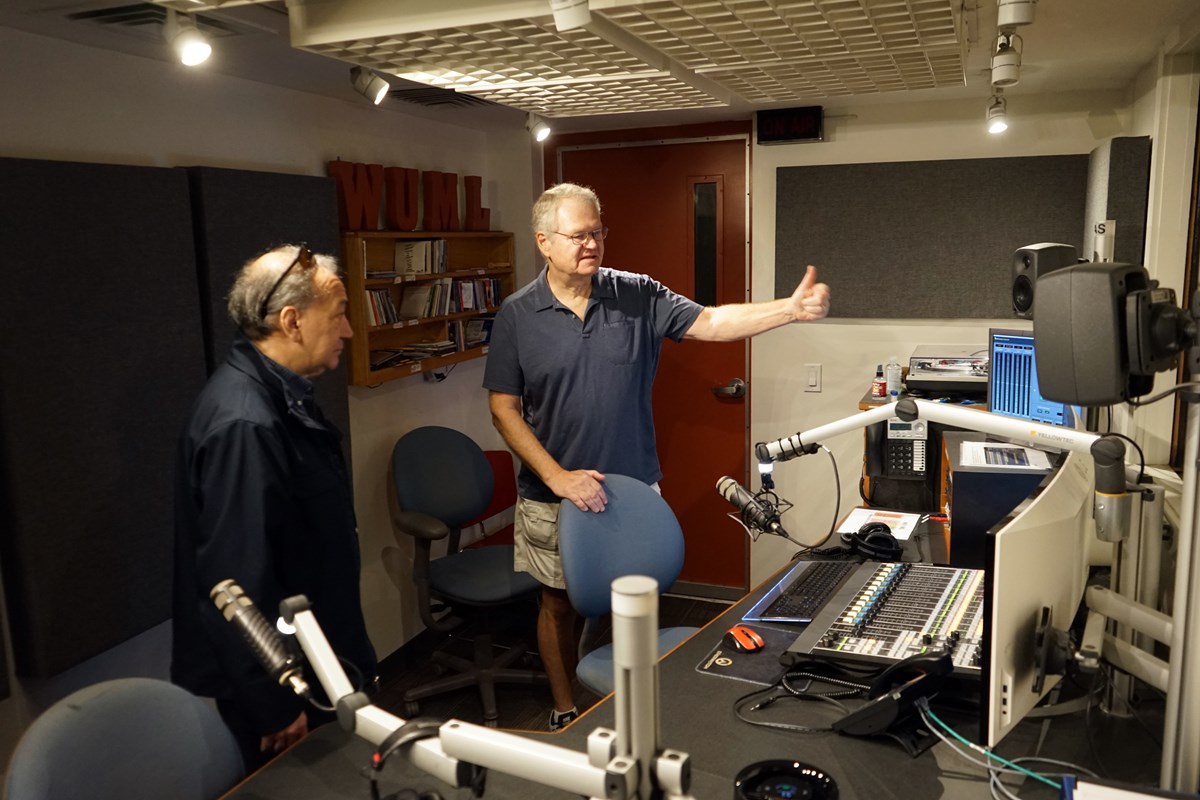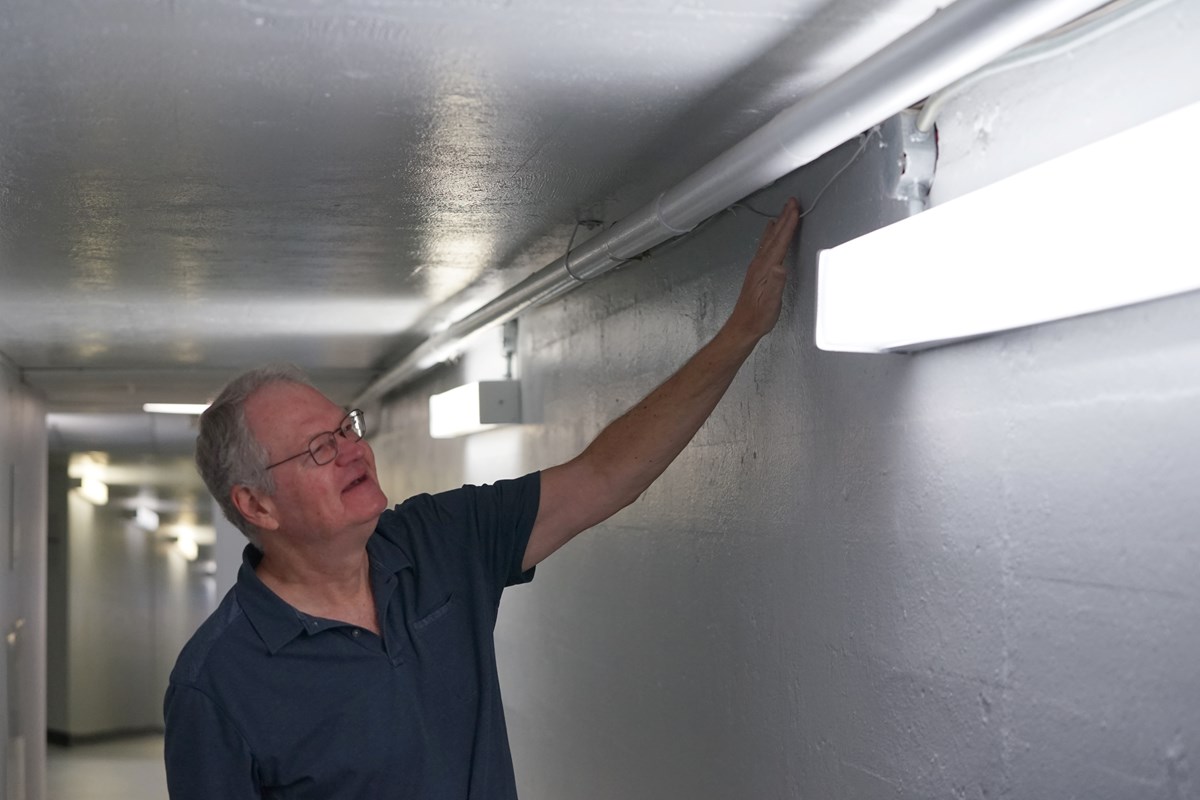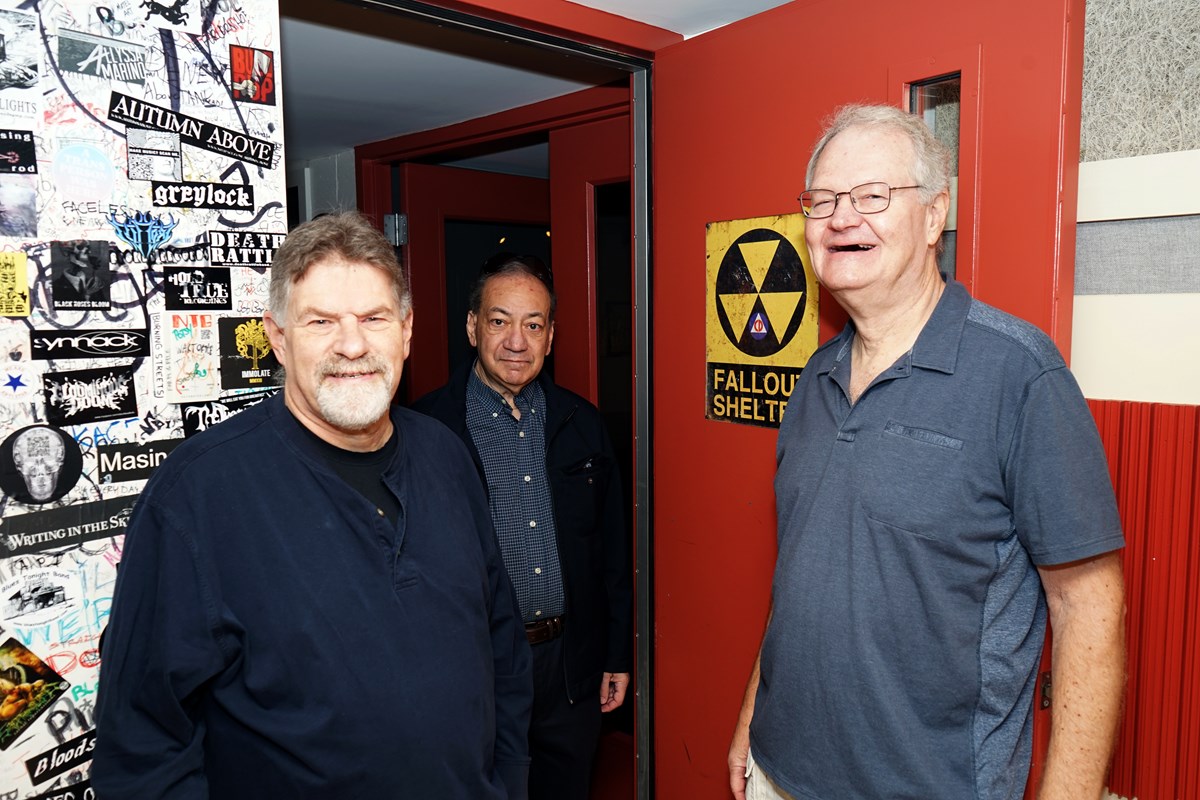 Image by Ed Brennen
Image by Ed Brennen
WUML DJs Ashley Kelly, left, and Freddy McWilliams, center, chat with alum Tony Janeczek '76, '86, who is helping to organize a reunion to celebrate the station's 70-plus-year history.
In 1952, Percy Faith, Jo Stafford and Eddie Boyd were topping the music charts, and an industrial engineering student named Edward Bonacci ’54 was living in the former Eames Hall on North Campus, where the Pulichino Tong Business Center now stands.
Bonacci liked to play records in his dorm room, and he built his own stereo amplifier to boost the sound coming from his speakers. One day, he was walking down the hall when he heard the record that he was playing coming from another room. Bonacci poked his head in the door and realized that some classmates had picked up the signal from his amplifier on their AM radio.
“We like your music,” they told Bonacci.
Inspired by this stereophonic serendipity, the students decided to create an actual AM radio station at what was then the Lowell Textile Institute. They scavenged for equipment, set up a studio in the basement of Kitson Hall (now Shah Hall) and, on January 15, 1953, began broadcasting as WLTI.
More than 70 years later, the station lives on as WUML (91.5 FM).
 Image by The Pickout
Image by The Pickout
Industrial engineering alum Edward Bonacci '54 started what is now WUML in his dorm room in 1952.
Proceeds from the event will benefit the station and the newly created WUML Edward L. Bonacci Memorial Endowed Scholarship Fund.
“It’s going to be a night to see old friends and commemorate Ed’s work to get things going,” says reunion organizer Tony Janeczek ’76, ’86, who spent four years at the station while earning an electrical engineering degree. He then served as an informal advisor to the station for nearly two decades while earning a master’s degree in computer science.
Broadcasting today on the FM dial and online, WUML has operated from the basement of Lydon Library on North Campus since 1971. Over the years, it has hosted live performances by artists such as Pixies, Jethro Tull and Frank Zappa at its sound studio, the Fallout Shelter. The station broadcasts UMass Lowell (UML) hockey games and recently hosted its annual Rock for Tots charity concert at Moloney Hall.
“It’s fantastic to see how the university has maintained and modernized the station. It’s very gratifying,” says Janeczek, who dropped by the studio on a recent Friday morning to reminisce with a few members of the reunion planning committee.
Despite the popularity of streaming music services, satellite radio and podcasts, terrestrial radio remains strong, with 82% of Americans age 12 and older listening in a given week, according to Nielsen Media Research.
This fall, WUML has 110 student broadcasters working as DJs, co-hosts and guests on 38 shows.
 Image by Ed Brennen
Image by Ed Brennen
John Guregian, left, who has broadcast the show "Blues Deluxe" on WUML for the past 45 years, checks out the studio with alum Tony Janeczek.
“I often feel like I’m part of something bigger than myself,” the Milford, Massachusetts, native says. “I've met some of my best friends through WUML and have learned so much — not just about radio, but also about communication, leadership and working with others.”
Tavares, who hosts the show “Flowers in the Rain” on Fridays from 8 to 10 p.m., says it’s “amazing” that alumni have created a scholarship.
“So many of us give so much of our time and energy to the station, so it's rewarding to see something like this scholarship happen,” she says.
Freddy McWilliams, a sophomore chemical engineering major from Concord, Massachusetts, was part of a student radio station in high school. When he saw that UML had a station, he was “dead set on getting involved.”
“Streaming services and podcasts are taking over, but a lot of people still listen to the radio in their car to and from work,” says McWilliams, who hosts two shows this year, “Hub Premium” on Mondays from 6 to 8 p.m. and “The Haters Union” on Fridays from 7 to 9 a.m.
 Image by The Pickout
Image by The Pickout
UML's student-run radio station got its start as WLTI, broadcasting from the basement of what is now Shah Hall.
“Even though it’s a large club with students from all different majors, everyone is pretty close,” McWilliams says.
Ashley Kelly, a sophomore biology major from Townsend, Massachusetts, is the station’s metal director.
“I’ve met a lot of new people and learned about a lot of new music genres,” says Kelly, who co-hosts the Friday morning show with McWilliams. “There’s a really good sense of community here.”
That would be music to Bonacci’s ears. In the Lowell Technological Institute’s 1954 yearbook, The Pickout, Bonacci said of the fledgling station, “We of WLTI feel that friendships and fellowships, built through the station’s activities, have been and will continue to be the greatest asset of WLTI.”
Tiger, who has worked as operations manager for two decades, says the popularity of podcasts has led to more students wanting to get involved to hone their broadcast skills in recent years.
“Since COVID, there’s been an uptick of people wanting to express their views and join the station,” he says. “We used to have one or two DJs in our main broadcast room, and all of a sudden I’d find dozens of chairs in there because everyone is huddled around the microphones.”
 Image by Ed Brennen
Image by Ed Brennen
Tony Janeczek looks at a wire in the tunnel under University Avenue that he helped install as a student to carry the broadcast signal from basketball games in Costello Gymnasium back to the studio in the basement of Lydon Library.
Rich Gingras ’79 and John Guregian both joined the station as business students in the 1970s. In 1980, they started a show called “Blues Deluxe,” which Guregian still hosts every Saturday from 3 to 6 p.m. He was recognized by the Blues Foundation with a 2023 “Keeping Blues Alive Award” in Memphis, Tennessee.
“It’s been great. I started out in college, and the show’s been on forever. It never stops,” says Guregian, a Chelmsford, Massachusetts, native who works as a senior contract analyst for Constellation Energy Solutions in Lowell.
Gingras remembers seeing an ad to join the station (then under the call sign WJUL) in The Connector student newspaper. He dropped by the studio, and the first person he met was Janeczek.
“And I never left,” says Gingras, who ended up serving as the station’s music director and on the broadcast crew for hockey games. After graduating, the Methuen, Massachusetts, native hosted a regular show until 1988. Today, he is a senior program manager for information technology services provider Avaya.
 Image by Ed Brennen
Image by Ed Brennen
Rich Gingras '79, left, John Guregian, center, and Tony Janeczek '76, '86 are part of the organizing committee for the reunion celebration and scholarship fund.
Bonacci, who went on to work on the Hubble Space Telescope, broached the idea of a scholarship fund at the station’s first reunion in 1986 (dubbed the “33 1/3 Reunion”). The scholarship never got off the ground, but Janeczek helped revive the idea with the Advancement Office after Bonacci passed away in 2020 at the age of 86.
“If we can relieve some of the financial pressure for students, that will enable them to focus on their schoolwork, which is the primary goal,” Janeczek says. “And it also will allow them to spend time at the station without having to worry about going to work.”
Like McWilliams, Janeczek knew he wanted to work on a radio station in college. When the Meriden, Connecticut, native toured campuses, he looked for FM antennas. At UML, he was happy to see one on the roof of Southwick Hall.
Janeczek did “a little of everything” at the station, but he was mostly interested in the technical side. He helped establish the station’s remote broadcast capabilities, and in 1994, he helped move the FM transmitter to the top of Fox Hall.
Now a communications systems engineer with Abacus Technology Corporation, Janeczek looks forward to celebrating the radio station that alumni have built over the past seven decades — while helping to ensure that students can keep the music playing for decades to come.
“Media is changing, but I think that students understand the need for an FM radio station,” he says. “They’ve grown up with podcasting and streaming music, but radio is still significant. It’s part of a bigger media landscape, and I think they do have an appreciation for it.”
